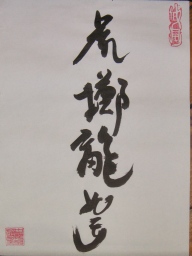Kotō Ryū Koppōjutsu – article translation
虎倒流骨法術
骨法といっても、今はやりの喧嘩芸との関係は無い。玉虎流を僧玉観から学んだ戸田左京一心斎が16世紀中頃に創始した。もともと骨法とは古代中国から伝わった技で、強法とも呼ばれ、隠し武器を使うのが特長だという。戸隠流とともに伊賀忍者から戸田家に伝えられ、やはり百地三太夫も学んでいる。初見氏によれば骨はの技コツに通じるという。
Kotō ryū koppōjutsu
Present day fighting techniques bear no relationship to what one might call koppo…
Toda Sakyō Isshinsai learned the Gyokko ryū of Sō Gyokkan and founded (this school) in the mid 16th Century. The technique of koppō was originally introduced from ancient China, also known as Gōhō (strong method), its speciality is to make use of hidden weapons. Transmitted to the Toda family along with Togakure ryū by the Iga ninja. Momochi Sandayū also learned this. According to Mr Hatsumi there is the ‘knack’ to understanding the technique of using the skeleton/bones.
虎倒 Kotō – tiger knocking down, tiger defeating, to fell a tiger.
僧玉観 Sō Gyokkan – a (Buddhist) monk, jewelled appearance. Looking at the Chinese for 玉観 you could also see the name as suggesting that this person is a treasured (possibly imperial) advisor or observer.
強法 Gōhō – strong or powerful method. Pronunciation as gōhō is indicated by furigana alongside kanji in the text.
The first line was particularly vexing to translate into something that made sense in English, after trying out several different versions I am currently happy with the one written above. Similarly with the last line there are various ways to phrase it in English, and thus subtly altering the meaning.
As with Togakure ryū in the genealogy chart, Kotō ryū is descended from the Gyokko ryū of Hachidō Nyūdō, but through Tozawa Hyakuunsai Kaneuji to Gyokkan who is seen as the source of four styles. Kotō ryū is passed on to Hatsumi Masaaki, as with Togakure ryū, through Momochi Sandayū, the Toda family, Toda Shinryūken Masamitsu and Takamatsu Toshitsugu.





Great info…very professional..
Thanks Mahoutsukai for the support, and thanks to those others who have shown their appreciation.
More to follow…